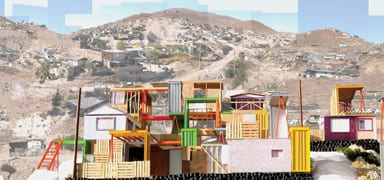
words Beatrice Galilee
A spindly half-broken umbrella and a thin plastic mac are all that shelter Teddy Cruz from the driving rain in the forecourt of the American pavilion in Venice. He makes a run for it through the Giardini to the “radical architecture” section of the Italian pavilion, where he is also showing his latest research.
The Guatemalan-born architect works in the complex communities on the boundary between North and South America, and his socially conscientious work is in demand. “One of the most interesting territories at the moment is Latin America because they’re trying to reinvent themselves and their institutions,” says Cruz, whose office is in San Diego, right on the border between the USA and Mexico. “By working with the social networks we believe there could be a new, very different paradigm. Unfortunately I don’t see many architects rushing to Bolivia or Peru or Caracas to participate in this debate.”
His position is summed up by a 30m-long banner strung across the front of the American pavilion, showing Californian mansions perching on poles in a slum. “Waste goes south,” says Cruz. “Tijuana recycles the leftover materials of San Diego for housing. Immigration has transformed the very nature of the American city out of informal, illegal economies and densities.” His kind of architecture is about researching systems and materials, fighting for politicians to take notice and finally intervening with a building, which serves as the beginning of a new process.
Cruz’s office also takes abandoned buildings and turns them into health centres and community hubs. In 1999 he launched a campaign to change San Diego’s planning laws. Zoning in some parts of the country restricts construction, regardless of size or social need. Cruz fought and won. His Casa Familiar project in the district of San Ysidro will see a development with 12 homes, a church converted into a community centre and a garden created for street markets. His case is clear: “It’s so important to think of housing differently, not as units thrown on the landscape, but strategically and politically about density and social structure.”
www.estudioteddycruz.com


















